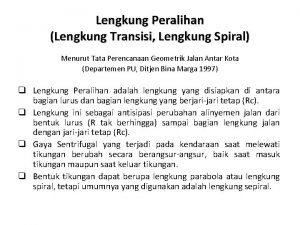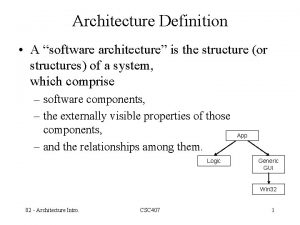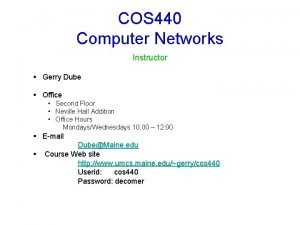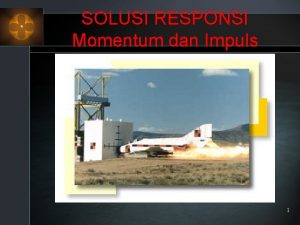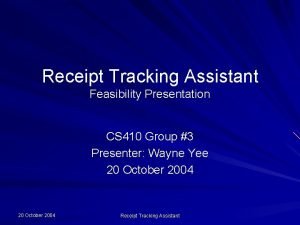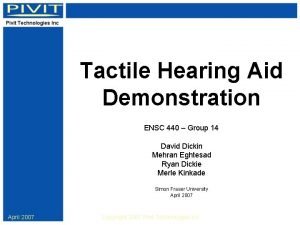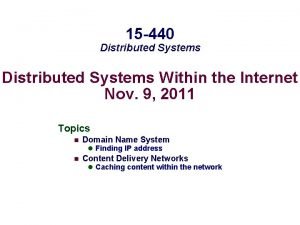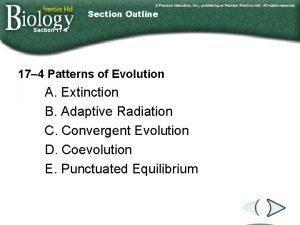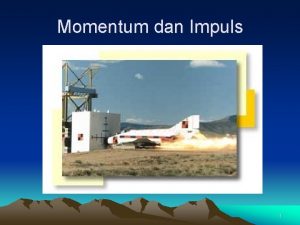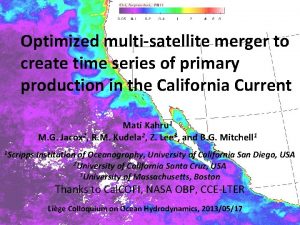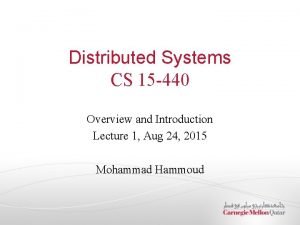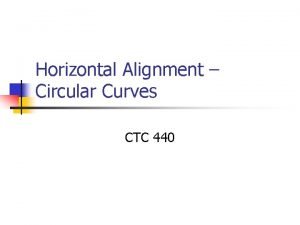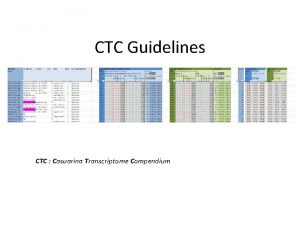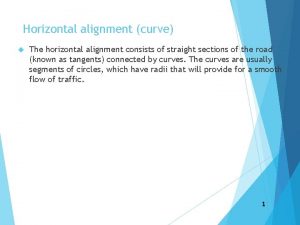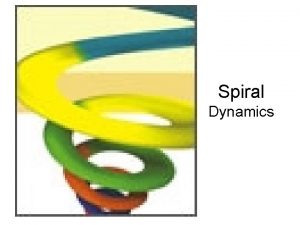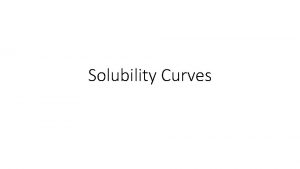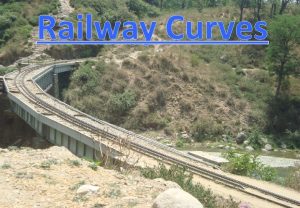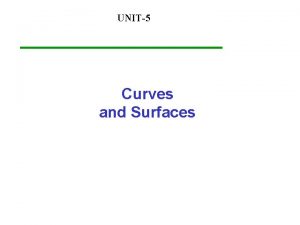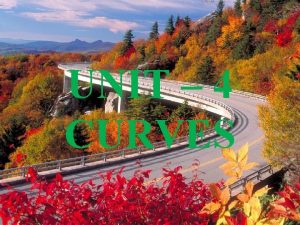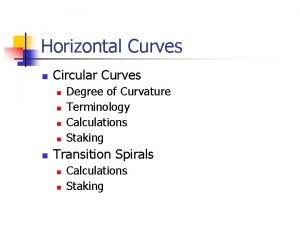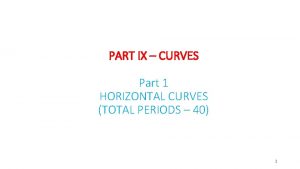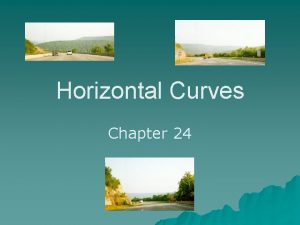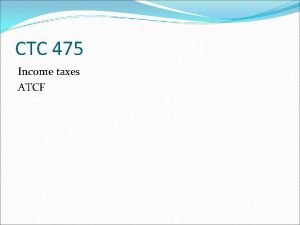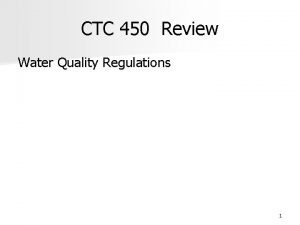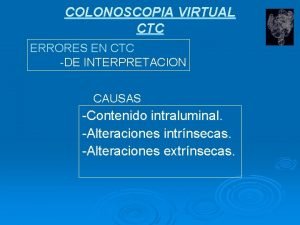Horizontal Alignment Spiral Curves CTC 440 From 20















![Basic Equations n n n Ts=(Rc+P)*tan(1/2*Δ)+K Es=[(Rc+P)/cos(Δ/2)]-Rc Θs=(Ls*Dc)/200 Δc= Δ-2* Θs Lc=(100*Δc)/Dc Basic Equations n n n Ts=(Rc+P)*tan(1/2*Δ)+K Es=[(Rc+P)/cos(Δ/2)]-Rc Θs=(Ls*Dc)/200 Δc= Δ-2* Θs Lc=(100*Δc)/Dc](https://slidetodoc.com/presentation_image_h/b640cddc8447b954c56df0d739f7a26a/image-16.jpg)






- Slides: 22

Horizontal Alignment Spiral Curves CTC 440

From “ 20 Things you Didn’t know about Cars”, Discover Magazine, October 2012 1. 2. 3. 11. 12. In 1760 King George III housed around 30 horses in the Royal Mews stables in London. Today a typical compact car packs a 150 -horsepower engine. So a suburban commuter has instant access to five times as much sheer muscle as the king who nearly crushed the American Revolution. By the formal definition of horsepower (the power required to lift 33, 000 pounds by one foot in one minute), a real horse musters only 0. 7 horsepower. Not only has the horse been outgunned by the car, it faces the further indignity of not being able to keep up with itself. …The contact patches-the area of the tires that actually touch the road at any given moment-cover an area of just over 100 square inches for an average family sedan. In other words, all of the accelerating, cornering, braking, and everything else that your four wheels do, happens on a piece of ground scarcely bigger than your own two feet.

Objectives n n Know the nomenclature of a spiral curve Know how to solve spiral curve problems

Spiral Curves n n When driving over simple horizontal curves, there is an abrupt change from a tangent to a circular arc at the PC Spirals are inserted between the arc and tangents to provide a gradual transition

Spiral Curves n n One end of the spiral has an infinite radius. At the other end, the spiral radius equals that of the connecting arc Typically the length of spirals on each size of the arc are the same

http: //www. nh. gov/dot/cadd/msv 8/spiral. htm

Spiral Curves n n TS-tangent to spiral SC-spiral to curve CS-curve to spiral ST-spiral to tangent

Spiral Curves n n Ls-Length of spiral; also the distance from TSSC and CS-ST (same as runoff length) Obtain from Tables 3 -2 & 3 -2 A (tables are rescinded---- use only for class!!) Note: 3 -2 & 3 -2 A are a shortcut since Exhibit 5 -15 is not available in english (use Tables 2 -11 thru 2 -14 (English) for super rates)

Rescinded—use only for this class!!

Rescinded—use only for this class!!

Spiral Curves n n n Ts-distance between the TS or ST and the PI Es-external distance between the PI and midpoint of the circular arc Δ-Deflection angle between tangents Dc -Degree of curvature of the circular arc Rc-radius of the circular arc

Spiral Curves n n n Θs-central angle of spiral Δc-central angle of the circular arc Lc -length of the circular arc

Spiral Curves n n n P-offset, throw or shift-distance in which the circular curve must be moved inward in order to provide clearance for inserting the spiral K-distance between TS & throw K, P can also be thought of as the coordinates of the (tangent to curve) where a tangent to the circular curve becomes parallel to the entering/existing tangent

Spiral Curves n n n Xc-distance between TS & SC measured along the forward tangent Yc-distance between TS & SC measured perpendicular to the forward tangent Xc, Yc can also be thought of as the coordinates of the SC from the TS

Spiral Curves n n LT-Long Tangent ST-Short Tangent
![Basic Equations n n n TsRcPtan12ΔK EsRcPcosΔ2Rc ΘsLsDc200 Δc Δ2 Θs Lc100ΔcDc Basic Equations n n n Ts=(Rc+P)*tan(1/2*Δ)+K Es=[(Rc+P)/cos(Δ/2)]-Rc Θs=(Ls*Dc)/200 Δc= Δ-2* Θs Lc=(100*Δc)/Dc](https://slidetodoc.com/presentation_image_h/b640cddc8447b954c56df0d739f7a26a/image-16.jpg)
Basic Equations n n n Ts=(Rc+P)*tan(1/2*Δ)+K Es=[(Rc+P)/cos(Δ/2)]-Rc Θs=(Ls*Dc)/200 Δc= Δ-2* Θs Lc=(100*Δc)/Dc

Example Problem Given: n Design speed=60 mph n emax =0. 06 n Δ=20 deg n Dc=4 deg n TS STA 121+00 n 2 -lane

Use worksheet: Found as. pdf in homework 4



Next lecture n Vertical Alignment

Review Questions n n n n n What do TS, SC, CS and ST stand for? If you know the station of the TS what do you add to get the station of SC? If you know the station of the SC what do you add to get the station of the CS? If you know the station of CS what do you add to get the station of the ST? K, P can be thought of the coordinates from what to what? Xc, Yc can be thought of the coordinates from what to what? What is the advantage of using spiral curves? Does a spiral curve have a constant radius? How do we define the spiral curve when setting a horizontal alignment?
 Tabel panjang lengkung peralihan
Tabel panjang lengkung peralihan Structure architecture definition
Structure architecture definition Difference between local and global alignment
Difference between local and global alignment Sequence alignment
Sequence alignment Bioinformatics
Bioinformatics Global alignment example
Global alignment example Jonathan pevsner
Jonathan pevsner Cos 440
Cos 440 Pimer monitor piattaforma
Pimer monitor piattaforma Bola dengan massa 0 440 kg yang bergerak ke timur
Bola dengan massa 0 440 kg yang bergerak ke timur Ai 440
Ai 440 Area code 440 location
Area code 440 location Ensc 440
Ensc 440 Textilexpo
Textilexpo Fin 440
Fin 440 15-440 cmu
15-440 cmu Polylite 440-m850
Polylite 440-m850 Section 17-4 patterns of evolution pages 435-440 answers
Section 17-4 patterns of evolution pages 435-440 answers Bola dengan massa 0 440 kg yang bergerak ke timur
Bola dengan massa 0 440 kg yang bergerak ke timur Ffsst
Ffsst 25-3/440
25-3/440 15-440
15-440 Ensc 440
Ensc 440
